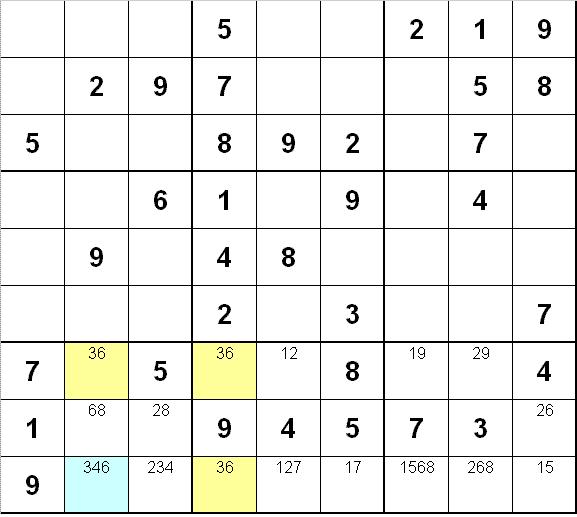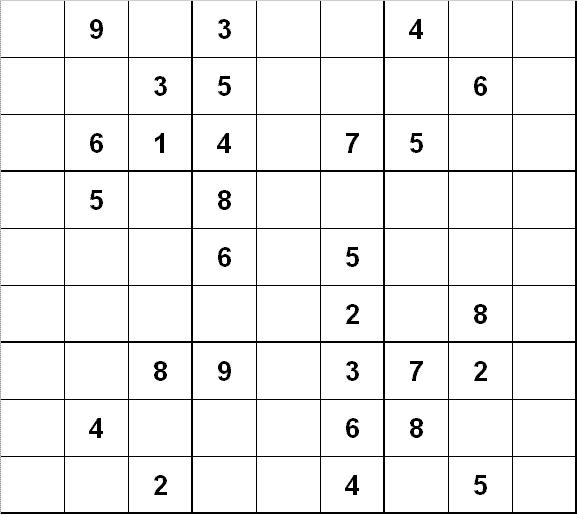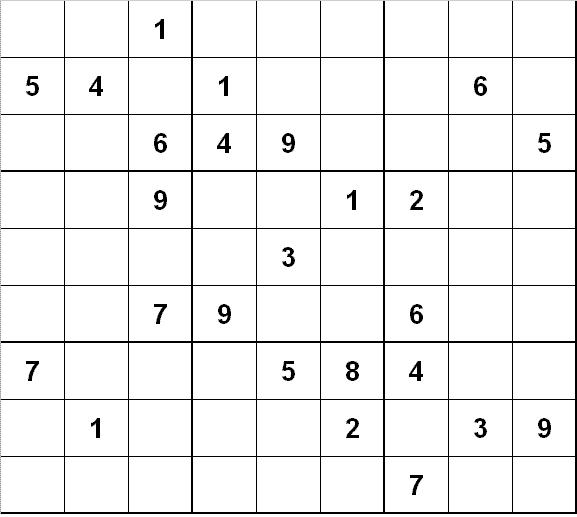This is another in my series of advanced sudoku strategies. I have arranged these caches so that you actually have to understand and use the technique and not simply throw it into a solver.
Impossible Rectangles are usually shown as an advanced strategy. However, they are very easy to understand and use. It is surprising how often you will run into them. Often they will allow you to jump ahead and solve the puzzle much faster than otherwise.
You should be aware that there is some controversy as to whether this is a legitimate strategy since it uses information not contained in the rules of Sudoku. However, the usual crowd doing my puzzles doesn't strike me as sticklers for petty details so I doubt I'll get many complaints.
The premise for this technique is that every "legitimate" Sudoku should have only one solution. The purists who dislike the series of "uniqueness" strategies point out that "uniqueness" is not written into the basic rule of Sudoku: Fill every cell on a 9x9 grid with a single digit from 1-9 without repeating any digit in any column, row, or 3x3 box on the grid. The purists will point out that most puzzles can be solved using other techniques without resorting to "uniqueness" strategies.
On the other hand, the other side points out that "most" is not "all" and those techniques can be pretty convoluted. Moreover, Sudoku puzzlers do not like puzzles that have more than one solution. Every so often the Saturday Sudoku in the SF Chronicle will have multiple solutions, and I HATE HATE HATE it when that happens. You can tell which side I support in this debate.
The principle is easier to demonstrate than it is to explain. Consider the following diagram. The three yellow squares can only contain a 1 or a 2. No other digits are possible. The blue and tan squares can only contain a 1, 2, or 3; again, no other digits are possible. Look at the blue square. If it contains a 1 or a 2, then the tan squares must be 3s. Now, look again at the rectangle formed by the yellow and blue squares. If the blue square contains a 1 or a 2, the yellow squares above and to the left must contain the other digit and the yellow square diagonal must contain that digit. However, there are now two different configurations possible (going clockwise): 1-2-1-2 or 2-1-2-1. We can't know which pattern is "the correct solution." However, we do know that there should be only one solution to this Sudoku. Therefore, the blue square cannot contain a 1 or a 2. Therefore it must contain a 3. The rest of the puzzle will tell you which digits now go into the rest of the colored squares.

Here is a complete puzzle adapted from Sudopedia. Notice that the yellow squares can only contain a 3 or a 6. The blue square can only contain a 3, 4, or 6. Since this puzzle should have only one solution, we know that the blue square cannot contain a 3 or a 6. Therefore it is a 4. [Email me if you don't understand why the blue square cannot contain an 8.]

Here is another complete puzzle adapted from Sudopedia. By now you should be able to recognize instantly that the blue square must contain a 9. Then the tan square contains a 2. You can now fill in the yellow squares and the rest of the puzzle.

Here are the ingredients for spotting an Impossible Rectangle.
1. Three cells must contain exactly two possibilities. The same two possibilities for each cell.
2. These cells must form three corners of a rectangle on the grid.
3. Furthermore [Very Important!!!!] the rectangle must be contained within a single band or stack of three 3x3 boxes. [Email me if this doesn't make sense.]
3a. Another way to look at this restriction is that the rectangle must be confined to exactly two different 3x3 boxes. [These two statements are geometrically equivalent.]
4. If these restrictions are in place, then the digits contained in the first three cells can be eliminated from the fourth cell that completes the rectangle.
The name "Impossible Rectangle" comes from the fact that the pattern is impossible in a "true" Sudoku. In the examples I have implied that that the fourth cell which completes the rectangle must contain exactly three digits, two of which are in the other three cells. Although this is usually the case, it is not necessary. The fourth cell can contain any number of digits. In fact it may only contain one of the two digits in the other three cells. The point to remember is that either of the two digits can be eliminated from the fourth corner no matter what else may be in that cell.
Now for the puzzle! The Sudokus below follow the same patterns as the examples above. Here you will find an Impossible Rectangle that will automatically leave a single digit in the fourth corner of the rectangle. In the first example that digit is 3. In the second, it is 4. In the third it is 9. Let this digit in the first Sudoku below be X. Let this digit in the second Sudoku below be Y. Then the cache is at N 37 31.ABC W 122 15.DEF. Use the following formulas. If the calculations for B, D, E and F result in a multi-digit number, take the final digit. Note that the asterisk * refers to multiplication.
A = X
B = (X + Y) * Y
C = Y
D = Y ^ X [i.e. Y to the power of X]
E = X * Y
F = X + X + Y + Y
Both of these Sudokus are adapted from ones by Tom Sheldon. For some reason, he seems unaware of the the Impossible Rectangle technique. He goes to great lengths to describe a trial and error technique that he calls "trailing." Yet, trial and error is exactly what it is. The Sudoku Solving Crowd hates trial and error (AKA "guessing") even worse than resorting to the Uniqueness techniques. You can probably solve these by convoluted coloring or some other such advanced technique, but why??? Find the Impossible Rectangle, fill in the fourth corner, and get on with the puzzle. [To be fair, he wrote near the beginning of the Sudoku craze, and many of the advanced techiques don't appear to have been well known and documented at that time.]
Here is the first Sudoku. If you studiously avoid Impossible Rectangles, you will hit a wall with 17 cells left to fill in. At that point, you either start guessing or using the Impossible Rectangle. Actually, the Rectangle becomes apparent relatively quickly. Feel free to use it as soon as you see it. Remember that this Sudoku will yield the X digit.

Here is the second. Again, if you studiously avoid Impossible Rectangles, you will hit a brick wall with 18 cells left to fill in. This puzzle is a little more tedious than the first one. This Rectangle appears later than the first one does, but it still becomes apparent with about 24-30 cells left to fill in, depending on how you attack the puzzle. Feel free to use it as soon as you see it. Remember that this Sudoku will yield the Y digit.

Please remember that I am not doing anything tricky here, although the description may be convoluted and dense. If anythiing is unclear, please let me know. I chose these Sudokus because as nearly as I can tell, you have to use an Impossible Rectangle to solve them.
One note of caution. One of the intriguing things about Sudoku is that there is often more than one way to solve them. (For example, when you hit the wall-block on the first puzzle, you will see an X-Wing, but it won't help you much.) You may use methods that will let you solve these puzzles without using an Impossible Rectangle. If so, you have my respect, but you don't have my cache. You have to find an Impossible Rectangle in these Sudokus to find the cache.
I fiddled with these diagrams and solved them six-ways-to-Sunday, but I may have missed something. It has happened before. If you notice a mistake or ambiguity, please just send me a gentle note and I'll get things fixed. Happy Puzzling, and thank you for doing my caches!
Note to the curious: Impossible Rectangles are the simplest example of Impossible Loops. An Impossible Loop can be 4-6-8 or any higher even number of cells long. Once you get to 6 cells or above in the loop, they don't need to be in the same band/stack as long as they would otherwise form a multiple solution if they were limited to the digits in the loop. As a rule, however, with one exception--which I will document in a further puzzle-- they are not really very useful. Moreover, the technique described above is actually known as a Type 1 Impossible Rectangle. Once given the premise of uniqueness, there are other deductions that can be made. If you are interested, I will describe them in other installments.